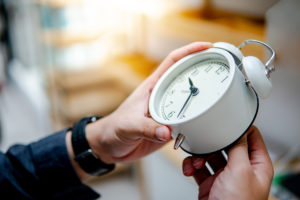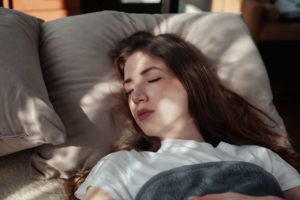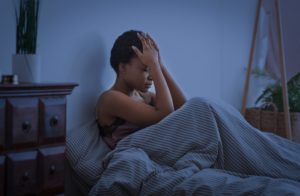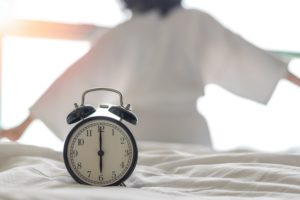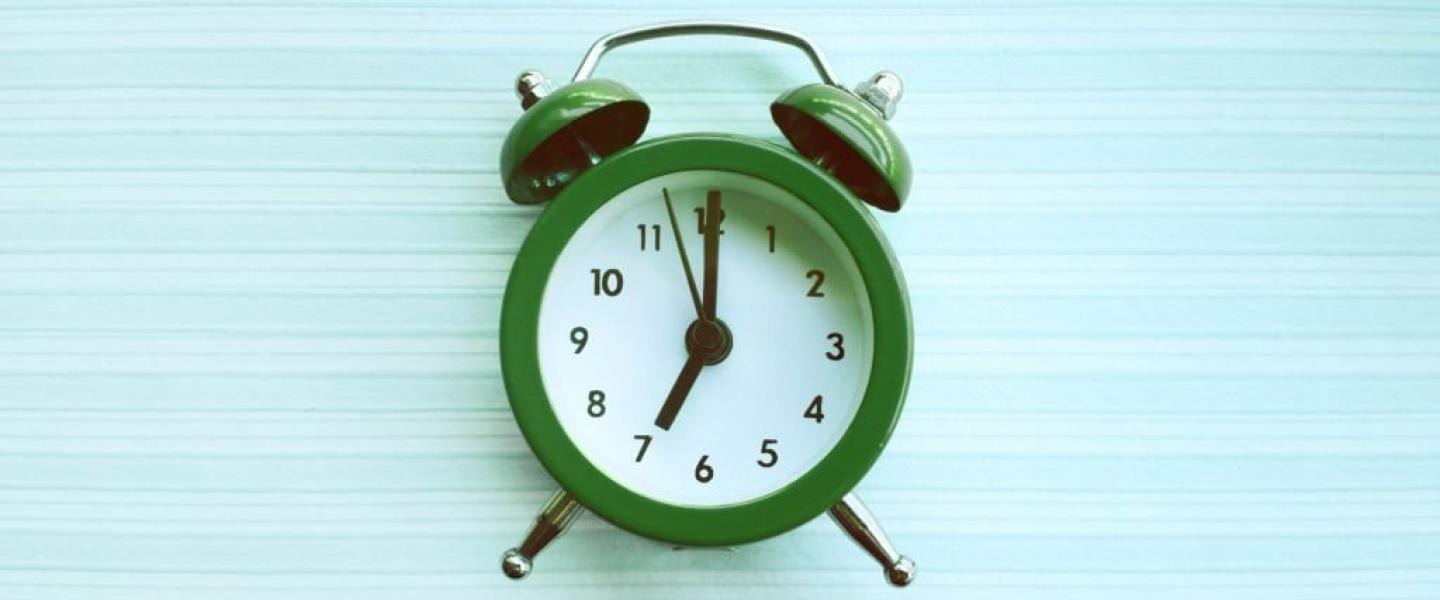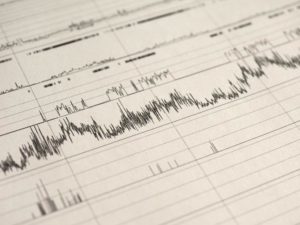Seasonal Affective Disorder: Sleep Tips to Beat the Winter Blues
If you experience major mood changes around the fall or winter, you are not alone. Seasonal affective disorder, also called SAD, impacts an estimated 5% of Americans. SAD is more than just the winter blues – it can significantly impact your day-to-day life and sleep patterns, leading to a cascade of negative effects on your overall well-being.
SAD symptoms are closely related to a person’s circadian rhythms, which influence when and for how long a person sleeps. Because of this, keeping your circadian rhythms in sync is essential to managing SAD symptoms.
What Is Seasonal Affective Disorder (SAD)?
Seasonal Affective Disorder (SAD) is a type of depression that occurs at specific times of the year, typically during fall and winter when there is less sunlight. The reduced exposure to sunlight during these seasons can affect the body’s internal clock, leading to a variety of symptoms, including:
- Disruptions in sleep patterns
- Irritability and mood changes
- Low energy
- Difficulty concentrating
- Feelings of sadness or hopelessness
- Changes in appetite and weight
Your Circadian Rhythm and SAD: What’s the Connection?
Because SAD occurs in relation to specific seasons, it is likely connected to circadian rhythms. Circadian rhythms, which impact the time a person sleeps, fluctuate over the course of each day and are most affected by exposure to light. When the seasons change, the timing of sunlight changes, which in turn affects circadian rhythms.
Experts have come up with two ideas. about why these shifts in sunlight and circadian rhythms might lead to SAD. The first is called the photoperiod hypothesis. A “photoperiod” refers to the time there is natural sunlight visible each day.
In winter, the time of natural sunlight each day shortens. This lack of light exposure likely leads to more melatonin being released, which may trigger depression in some people. This lack of light exposure may also lead to a hibernation response that involves a desire to eat and sleep more in winter months.
The second idea about how circadian rhythms affect SAD is called the phase shift hypothesis. This idea suggests that when circadian rhythms become misaligned with a person’s sleep schedule, they develop SAD. Since daylight begins later on winter days, circadian rhythms may become delayed.
Our Best Sleep Tips to Help Relieve SAD Symptoms
Since SAD is so closely linked to circadian rhythms and sleep, taking steps to improve sleep and keep your circadian rhythms aligned can be part of an effective seasonal affective disorder treatment plan.
Try Bright Light Therapy
Multiple research studies suggest that bright light therapy can help reduce or eliminate SAD symptoms in about 60% of people who have the disorder. Bright light therapy may be especially helpful for people whose symptoms are mild and those whose symptoms include a tendency to sleep and eat more than usual or crave carbohydrates.
With bright light therapy, a person receives light exposure from a special seasonal affective disorder lamp that mimics the sun. Many studies have participants use therapy lamps for 30 minutes per day, with light that measures 10,000 lux. This light exposure can impact a person’s circadian rhythms in a way that helps bring them into alignment.
When a person experiences SAD in the fall or winter, studies suggest that using bright light therapy in the early morning is most helpful. Rather than wait until symptoms appear, experts suggest that people who develop SAD in the fall or winter begin light therapy two to four weeks before their symptoms usually begin.
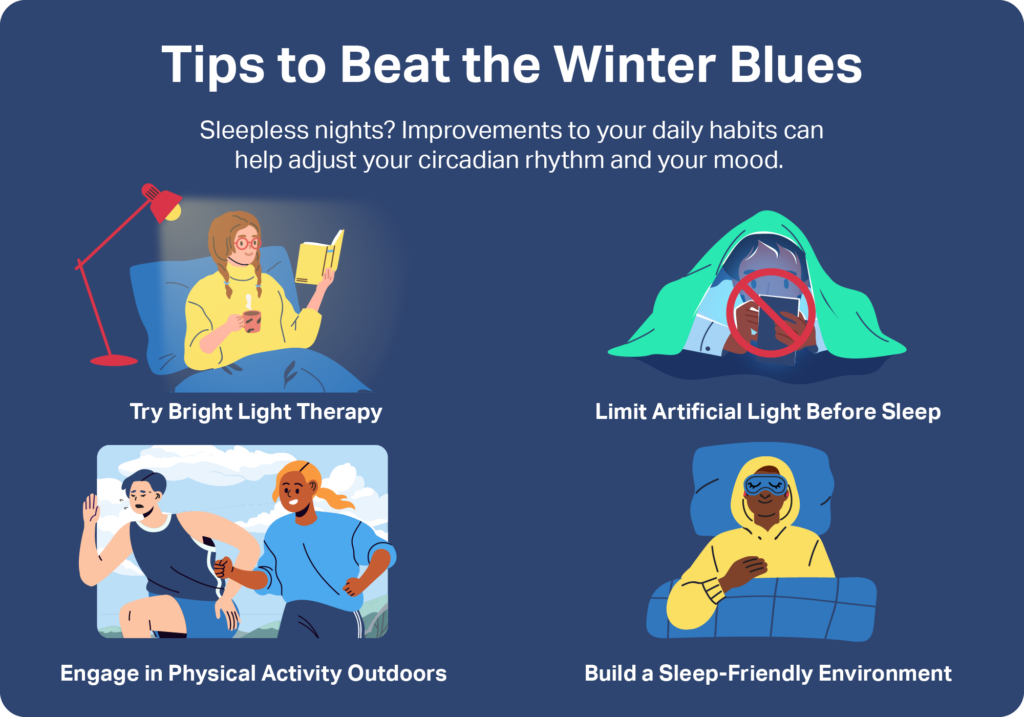
Limit Artificial Light Before Sleep
Just as morning light exposure might help reduce SAD symptoms, nighttime light exposure might increase SAD symptoms. Exposure to light in the evening may delay a person’s sleep schedule, causing them to stay up later or have trouble falling asleep. For these reasons, limiting artificial light in the two hours before bed could help a person managing SAD.
Bluelight from digital devices is especially important to avoid before bed, because of how it impacts the body. Dim overhead lights and try not to watch TV, use a computer, or look at a smartphone or tablet in the two hours prior to bedtime.
Engage in Physical Activity Outdoors
Walking or exercising outdoors during the wintertime might help reduce SAD symptoms. Even on a cloudy day, being outside for an hour exposes a person to sunlight. Receiving sunlight exposure may reduce SAD symptoms by impacting a person’s circadian rhythm. Consider walking or working out in the morning or midday, when the sun is brightest.
Go to Sleep and Wake Up at the Same Time Every Day
Irregular sleep patterns or significant shifts in sleep schedules can disrupt your circadian rhythm, leading to difficulties falling asleep or waking up at the desired times. Consistency minimizes these disruptions, helping maintain the natural flow of the circadian cycle.
A consistent sleep schedule reinforces the alignment of your internal biological clock with external environmental cues, particularly the natural light-dark cycle. This alignment optimizes the release of sleep-regulating hormones, facilitates proper sleep architecture, and promotes overall well-being by supporting various internal processes governed by the circadian rhythm.
Your sleep patterns are also closely related to mental health and disruptions in sleep schedules can contribute to changes in mood, irritability, and stress.
Build a Sleep-Friendly Environment
Practicing healthy sleep habits may also help manage SAD symptoms. One way to promote sleep is to make sure your sleep environment is sleep-friendly.
- Set the thermostat to a cool temperature
- Turn off bright lights and instead use dim lamps
- Remove devices like TVs, computers, tablets, and phones from the bedroom
- Try to keep the bedroom quiet
- If light enters the room, use light-blocking curtains or an eye mask to block it out
When to Seek Professional Help
If you are experiencing symptoms of depression or SAD, you should talk to your doctor or a mental health counselor. Your doctor or therapist can create the right treatment plan for you. Common treatments include therapy, medications like antidepressants, and, in the case of SAD, bright light therapy.
If you are having thoughts that involve hurting yourself or others, and you need immediate help, go to your nearest emergency room or dial 9-1-1.

Still have questions? Ask our community!
Join our Sleep Care Community — a trusted hub of sleep health professionals, product specialists, and people just like you. Whether you need expert sleep advice for your insomnia or you’re searching for the perfect mattress, we’ve got you covered. Get personalized guidance from the experts who know sleep best.
References
2 Sources
-
Avery, D. (2022, September 1). Seasonal affective disorder: Epidemiology, clinical features, assessment, and diagnosis. In. P. P. Roy-Byrne (Ed). UpToDate.
https://www.uptodate.com/contents/seasonal-affective-disorder-epidemiology-clinical-features-assessment-and-diagnosis -
Avery, D. (2022, September 1). Seasonal affective disorder: Treatment. In. P. P. Roy-Byrne (Ed). UpToDate.
https://www.uptodate.com/contents/seasonal-affective-disorder-treatment


